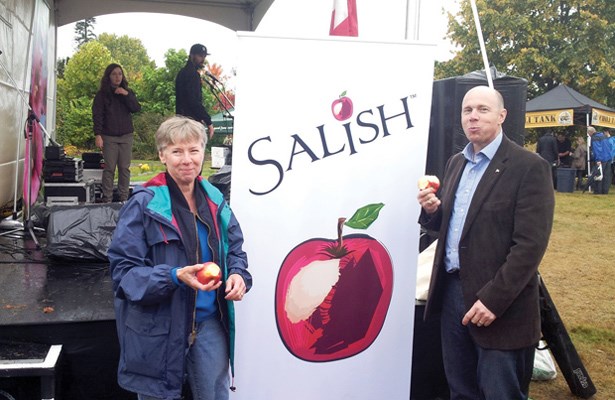ALMOST everyone loves to bite into a juicy, crunchy red apple with lots of taste, and this year there's a new apple for us all to enjoy which was bred and raised right here in B.C.
It seems I was in the right place at the right time while I was volunteering recently at the University of British Columbia Botanical Garden's Apple Fest when a brand new apple was unveiled to the public. On hand for the unveiling was John Kingsmill, the CEO of the Okanagan Plant Improvement Corporation, Kelowna-Lake Country Member of Parliament Ron Cannan and Cheryl Hampson of Agriculture and Agri-Food Canada. Bred and raised at the Pacific Agri-Food Research Centre in Summerland, the apple is called "Salish" after the aboriginal languages of the Thompson, Okanagan-Colville and Shuswap peoples. PICO commercializes fruit varieties, both domestically and internationally, by managing intellectual property rights and supporting product development and testing with a focus on improving the competitiveness of Canada's tree fruit and berry growers. The AAFC has a program called Developing Innovative Agri-Products to support industry-led science and technology projects. The goal of DIAP is to encourage innovation and private sector investment in the commercialization of new and value-added agricultural products.
During my conversation with Salish apple breeder Cheryl Hampson, I discovered some interesting facts about apple breeding.
Firstly, this apple was bred using the ancient, safe, tried and true methods of cross pollination. No genetically modified Franken-fruit here, Salish is all natural and she's a beauty.
Those are my words, not Hampson's. I am telling you that because I believe that genetically modified foods will become evermore prevalent in our society unless we tell bureaucrats and politicians that we do not want to eat some abomination created in a lab that is released into the environment with untold consequences that cannot be realized for years perhaps decades. But I digress. . . .
Hampson described to me in detail the complex process of breeding an apple.
The Salish apple's birth began in 1981 as a seedling resulting from a cross between "Splendor" and "Gala" apples.
Hampson went on to say, "We grow several thousand seedlings each year of varying species and crosses. As the seedlings develop over time we select plants we believe will hold promise for commercial fruit production. It takes a long time to fully develop a new variety for market, as long as 20 years, and we work closely with industry and participating growers to choose varieties with qualities best suited to intensive commercial production."
While I listened to Hampson describe the detailed process of plant selection, grafting and growing I could tell she was dedicated to her work. She spoke passionately, confidently and articulately about how the process is accelerated using safe, proven methods of pollination, bud-grafting and scientific selection to accelerate growth rates to achieve the desired maturity and fruiting so selection can take place in as short a time as possible.
Even after breeders like Hampson finish their part of the breeding process, commercial fruit growers carry out farm testing of the new tree to determine its suitability for full scale production. It may seem like breeding new fruit varieties takes a long time, but unlike the unproven and potentially damaging environmental effects of genetically modified breeding, cross pollination of new plant species has been safely and successfully practiced for several thousand years.
I wanted to talk longer with Hampson but some ministry bureaucrat intruded into our conversation and our enlightening talk soon ended.
I had the pleasure of tasting the new Salish apple and she is crisp, sweet with a mild tang, juicy and deeelicious.
The apple itself is fairly big, primarily red with a yellow under-colour and firm.
I enjoyed the Salish apple so much that I bought two bags full while I was at Apple Fest. As a matter of fact, I am eating a Salish apple as I write this story; excuse me while I have another bite.
I found another interesting fact about apples during my time at Apple Fest; according to a study done by the AAFC on the degree-of-liking among metropolitan consumers of varying ages, genders and ethnicities it seems Europeans generally prefer to eat primarily tart and sweet apples while Asians prefer to eat sweet apples.
I love almost any apple whether it's tart, sweet, big, small, red or yellow as long as it's not genetically modified, and preferably organically grown.
Several orchards in the Okanagan have committed to growing the Salish apple. MarketPlace IGA in West Vancouver and perhaps other grocery stores will be selling the Salish apple. Now, all our B.C. growers need is consumer support to make the Salish apple a bred-in-B.C. success story.
Todd Major is a journeyman horticulturist and chief horticultural instructor at the University of British Columbia Botanical Garden. For advice contact him at [email protected].



